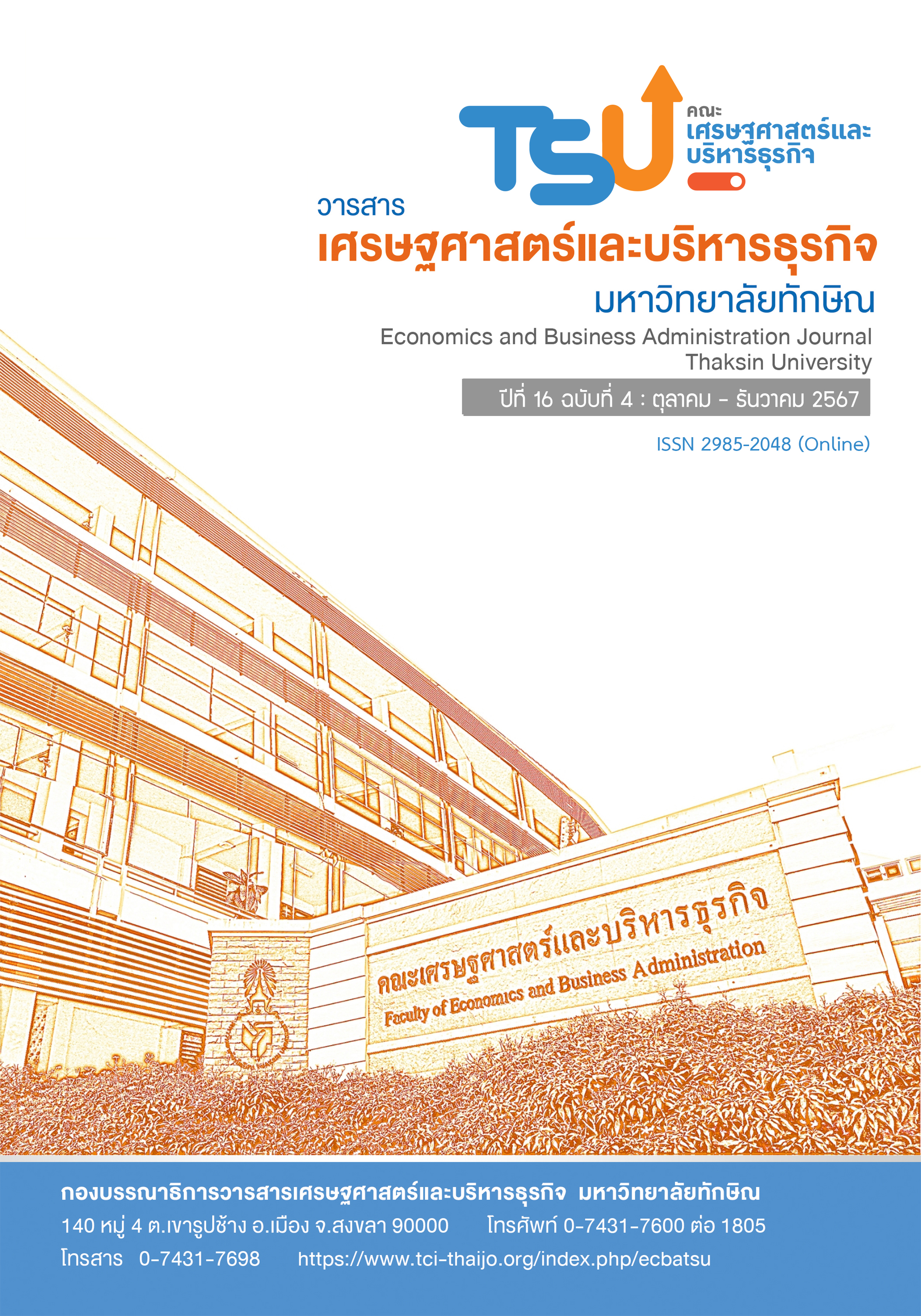การพยากรณ์แนวโน้มท่องเที่ยวในเขตพัฒนาพิเศษภาคตะวันออก (EEC) ด้วยกูเกิลเทรนด์
DOI:
https://doi.org/10.55164/ecbajournal.v16i4.267214คำสำคัญ:
กูเกิลเทรนด์, การท่องเที่ยว, ความถี่ผสม, เขตพัฒนาพิเศษภาคตะวันออก, การพยากรณ์บทคัดย่อ
การศึกษาครั้งนี้มีวัตถุประสงค์เพื่อทดสอบความสามารถของตัวแปรกูเกิลเทรนด์ในการพยากรณ์แนวโน้มการท่องเที่ยว และประเมินผลกระทบจากสถานการณ์โรคติดเชื้อไวรัสโคโรนา 2019 (COVID-19) ต่ออุตสาหกรรมการท่องเที่ยวในเขตพื้นที่ EEC ที่เป็นแหล่งรายได้สำคัญของครัวเรือน ข้อมูลที่งานวิจัยใช้ ได้แก่ ข้อมูลจำนวนนักท่องเที่ยว ความถี่รายเดือน และข้อมูลกูเกิลเทรนด์เกี่ยวกับการท่องเที่ยว ความถี่รายสัปดาห์ ครอบคลุมตั้งแต่เดือนมกราคม พ.ศ. 2558 ถึง เดือนมิถุนายน พ.ศ. 2564 จากการประมาณค่าโดยใช้แบบจำลอง Autoregressive และแบบจำลอง ADL- MIDAS พบว่า ตัวแปรกูเกิลเทรนด์ช่วยเพิ่มความสามารถในการอธิบายการเปลี่ยนแปลงของจำนวนนักท่องเที่ยวได้ โดยมีความสัมพันธ์ในทิศทางเดียวกัน อีกทั้งการเพิ่มตัวแปรกูเกิลเทรนด์ในแบบจำลอง Autoregressive ทำให้การพยากรณ์มีความแม่นยำมากขึ้น ในขณะที่แบบจำลอง ADL-MIDAS เหมาะกับใช้พยากรณ์ในสถานการณ์ที่ไม่ปกติ อย่างเช่นในช่วงเศรษฐกิจถดถอยหรือเกิดโรคระบาด นอกจากนี้ การศึกษาผลกระทบจากสถานการณ์โรคติดเชื้อไวรัสโคโรนา 2019 พบว่าการค้นหาข้อมูลท่องเที่ยวลดลงเมื่อมีการระบาดของโรค สอดคล้องกับจำนวนนักท่องเที่ยวและรายได้จากนักท่องเที่ยวลดลง ซึ่งตัวแปรกูเกิลเทรนด์ จะช่วยให้ผู้ดำเนินนโยบายสามารถคาดการณ์จำนวนนักท่องเที่ยวและเตรียมพร้อมรับสถานการณ์ได้ดียิ่งขึ้น
References
Andreou, E., Ghysels, E., & Kourtellos, A. (2013). Should Macroeconomic Forecasters Use Daily Financial Data and How? Journal of Business & Economic Statistics, 31(2), 240-251.
Askitas, N., & Zimmermann, K. F. (2009). Google Econometrics and Unemployment Forecasting. Applied Economics Quarterly, 55(2), 107-120.
Chinsiraprapha, A. (2021). The Impact of COVID-19 on the Tourism Economy in the Eastern Region. Journal of Industrial Business Administration, 3(2), 1–4. Retrieved from https://so03.tci-thaijo.org/index.php/iba/article/view/257511
Choi, H., & Varian, H. (2009). Predicting Initial Claims for Unemployment Benefits. Google Inc, 1, 1-5.
Engle, R. F., Ghysels, E., & Sohn, B. (2013). Stock Market Volatility and Macroeconomic Fundamentals. Review of Economics and Statistics, 95(3), 776-797.
Ettredge, M., Gerdes, J., & Karuga, G. (2005). Using Web-based Search Data to Predict Macroeconomic Statistics. Communications of the ACM, 48(11), 87-92.
Ghysels, E., Santa-Clara, P., & Valkanov, R. (2004). The MIDAS Touch: Mixed Data Sampling Regression Models. UCLA: Finance. Retrieved from https://escholarship.org/uc/item/9mf223rs
Gulati, V. (2023). EEC Economy in 2022 and Outlook in 2023. Retrieved February 1, 2023, from https://www.scbeic.com/th/detail/product/8749
Havranek, T., & Zeynalov, A. (2021). Forecasting Tourist Arrivals: Google Trends Meets Mixed-frequency Data. Tourism Economics, 27(1), 129-148.
Hopken, W., Eberle, T., Fuchs, M., & Lexhagen, M. (2019). Google Trends Data for Analysing Tourists’ online Search Behaviour and Improving Demand Forecasting: the Case of Åre, Sweden. Information Technology & Tourism, 21, 45-62.
Jiranyakul, K. (2019). The Validity of the Tourism-Led Growth Hypothesis for Thailand. Available at SSRN 2816239.
Kapetanios, G., & Papailias, F. (2018). Big Data & Macroeconomic Nowcasting: Methodological Review. Economic Statistics Centre of Excellence (ESCoE) Discussion Papers ESCoE DP-2018-12, Economic Statistics Centre of Excellence (ESCoE).
Keerativibool, W. (2013). Forecasting Model for the Number of International Tourist Arrivals to Thailand. Srinakharinwirot Science Journal. 29(2), 9-26.
Kingnetr, N., Tungtrakul, T., & Sriboonchitta, S. (2017). Forecasting GDP Growth in Thailand with Different Leading Indicators Using MIDAS Regression Models. Robustness in Econometrics, 692, 511-521. DOI: https://doi.org/10.1007/978-3-319-50742-2_31
Kingnetr, N., Tungtrakul, T., & Sriboonchitta, S. (2018). Does Forecasting Benefit from Mixed-frequency Data Sampling Model: The Evidence from Forecasting GDP Growth Using Financial Factor in Thailand. International Conference of the Thailand Econometrics Society, 753, 430-442. DOI: https://doi.org/10.1007/978-3-319-70942-0_31
Kuzin, V., Marcellino, M., & Schumacher, C. (2011). MIDAS vs. Mixed-frequency VAR: Nowcasting GDP in the Euro Area. International Journal of Forecasting, 27(2), 529-542.
Nakavachara, V., & Lekfuangfu, N. W. (2018). Predicting the Present Revisited: The Case of Thailand. Thailand and The World Economy, 36(3), 23-46.
Onder, I. (2017). Forecasting Tourism Demand with Google Trends: Accuracy Comparison of Countries vs. Cities. International Journal of Tourism Research, 19(6), 648-660.
Prajongkarn, W., Reancharoen, T., & Surawattananon N. (2020). How to Switch on the Tourism Sector to be Worth the Risk. Retrieved January 29, 2021, from https://www.bot.or.th/Thai/ResearchAndPublications/articles/Pages/Article_13Oct2020.aspx.
Rangsipol, K. (2021). EEC Economy in a New Wave of COVID-19 Outbreak. Retrieved February 1, 2023, from https://www.scbeic.com/th/detail/product/7321
Rungjindarat , N., & Phansaita, N. (2018). Forecasting Russian Tourist Arrivals to Thailand Using SARIMA Model. Dusit Thani College Journal, 10(1), 180-191.
Sangkhamaneenakon, O. (2018). Can Google Trends Help to Predict Financial Market (SET50). Thammasat University.
Stephens-Davidowitz, S., & Varian, H. (2014). A Hands-on Guide to Google Data. Technical report, Google.
Untong, A. (2014). Examining the Tourism-led Growth Hypothesis: A Case Study of Thailand. Applied Economics Journal, 21(2), 30-51.
Wichitaksorn, N. (2020). Analyzing and Forecasting Thai Macroeconomic Data Using Mixed-Frequency Approach (Discussion Paper No. 146). Puey Ungphakorn Institute for Economic Research. https://www.pier.or.th/dp/146/
Downloads
เผยแพร่แล้ว
How to Cite
ฉบับ
บท
License
Copyright (c) 2024 Faculty of Economics and Business Administration, Thaksin University

This work is licensed under a Creative Commons Attribution-NonCommercial-NoDerivatives 4.0 International License.



